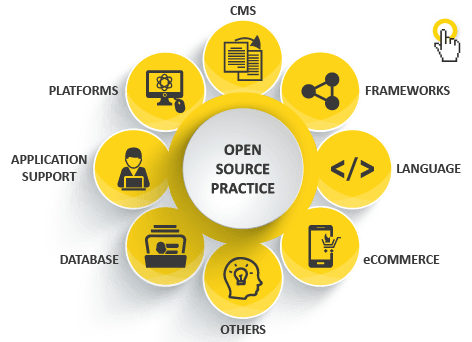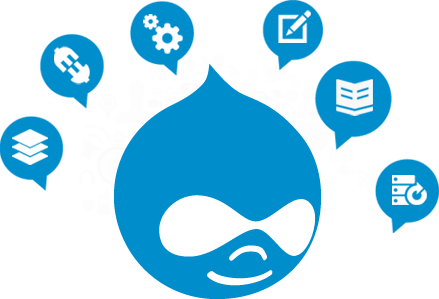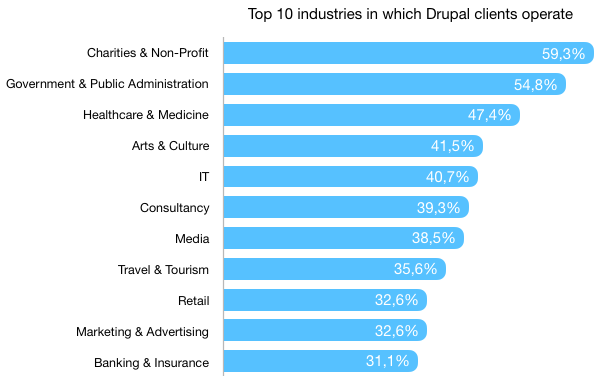We all have heard about Didier Claude Deschamps, right?
He is a French retired footballer who has been the manager of the France national team since 2012. He played as a defensive midfielder for several clubs such as Marseille, Juventus, Chelsea, Valencia, Nantes, and Bordeaux.
Why was he famous? Well, mainly because he was a silent performer who did the best for his team and created a special place in the minds of his fans and the supporters.
His biggest USP: being unique in a way that it was relevant and appealing for everyone around.

The role played by Didier Claude Deschamps as a coach and as a team member was exquisite. He not only served as a striking ray of hope by bagging exciting titles but also became an overnight hero.
And Drupal is just like Didier Claude Deschamps for large organizations. Powerful, all-rounder and robust.
With roughly 1.2 million websites using Drupal across the world, it is clearly a strong content management system capable of supporting large organizations.
Let’s take a look at technical and business reasons as to why large organizations rely on Drupal to achieve their goals.
Open Source Has its Own Perks
Open source has presented users with open source codes. The source code enables access to the common public for their use and modifications in the original design.
Open-source code is expected to be a collaborative effort, where the programmers fix or change the source code and share it within the community.
Social and political views have been influenced by the growing concept of open source. There is a much larger impact of the open-source movement and the extent of its role in the development of new information sharing procedures.
The open-source movement has not only enhanced transparency in the biotechnology but the research methodologies have also benefited from the applications of open-source principles.
One of the main advantages of using open source is that it is not limited. Any organization can build a secure and safe online presence with the help of its capabilities. Some of the major functionalities provided by the open source are:
- Since open source provides with open code its quality can be easily and greatly improved when it is passed around, tested, and fixed.
- Open Source provides with a valuable learning opportunity for programmers. They can apply skills to the most popular programs available today.
- Open Source is more secure than any other proprietary software because bugs are identified and fixed quickly.
- Since it is in the public domain, and constantly subject to updates, there is little chance it can become unavailable or quickly outmoded—an important plus for long-term projects.

Presenting Drupal for Large Enterprises
Large or big organizations understand that their website is the foundation for the online presence. It is the structure on which their business (or marketing) is based on.
These organizations require a seamless and fully functional website. They opt for that CMS which provides them various features and functionalities.
Drupal is one of those open source CMSes which is suitable for any type of digital presence, with a strong focus on personalization, community building, and social tools.
Drupal provides enterprises with:
Excellent Security
The ability of Drupal to limit security vulnerabilities is one of the most important features of the CMS, and one of the principal reasons why large websites work with the platform.
Due to the excellent protection of the sensitive data, Drupal is chosen instead of other available CMS. Drupal also meets the Open Web Application Security Project (OWASP) security standards and addresses critical security risks. The platform has a dedicated security team who presents information to project maintainers, train the Drupal community on security topics and make improvements related to security in a core and contributed projects.
CMS which is flexible and scalable
When building a professional website, the main thing to take into consideration is the flexibility and scalability of the software that runs the website. And yes, Drupal is one of the most flexible and scalable CMSes for constructing any kind of website.
Whether the user is thinking to create news, government platforms, higher education, enterprise or NGO website, Drupal creatively combines the correct modules and custom code to construct a truly different experience for the visitors.
Highly customized websites that need scalability and serve with a huge amount of data are going to find Drupal absolutely capable of handling the workflow.
Provides easy content authoring
Drupal presents an intuitive tool for creating content, maintaining workflow and secure publishing for each and every online content.
The CMS provides easy authoring of the data to the website administrators, marketers and content managers. The website administrators can grant permission to other staff members to perform administrative tasks.
Has a dedicated community
Drupal community is one of the largest and most important assets.
Being one of the largest open source online communities, more than 1 million strong developers, designers, trainers, strategists, coordinators, editors, and sponsors run together towards accomplishing one goal: making the web a better place for everyone.
Cost efficiency
Drupal is one of those platforms that is free and is written in PHP which is distributed under GNU (General Public License). The installation of the Drupal core can provide a simple website, an internet forum, a single-user or multi-user blog or a community-based website.

Is Drupal Right for My Sector?
Having this question in mind?
It is really normal. Trusting a CMS that coincides with your needs and requirements is something every large organization in every sector wants.
Whether it is a government or a public administrator sector or healthcare and medicine, Drupal is the platform which is suitable for every sector.

According to the Drupal business survey conducted in 2018, Drupal enterprise has clients in diverse industries. Half of the respondents (nearly 59.3 %) stated having Drupal clients in Charities and Non-Profit organizations.
Among other industries, there were Government and Public Administration (about 54.8 %), Arts & Culture (41.5 %), Healthcare & Medicine (47.4 %) and IT (40.7 %).
The result of the survey reveals that the businesses of Media and Banking and Insurance have had the highest drop as compared to last year survey, while Healthcare and Medicine and Consulting industry have developed the most and learned from the first survey.
Decision-Making Model for Large Organizations
One of the sessions in Drupal Europe, which was on Compelling USPs for Drupal in large organizations (conducted by Digitalization and Innovation Specialist, Mr. Rouven Volk) was about how large enterprises values are defined by an increase in revenue and a decrease in cost and risks. These enterprises look for CMS solutions that involve:
- Responsive and SEO based platform
- The CMS which consists of Marketing Integration
- It involves a flexible solution
- It has the necessary modules and additional features
- It is proven in terms of scalability and flexibility
- It should give excellent user experiences
- The cost should be minimized
- Multitenancy
Some of the Challenges that Might Occur and Their Solutions
As the organizations continue to embrace digital transformation, they are finding that digital business is not as simple as buying the latest technology, it requires significant changes to both culture and systems. To sustain the digital transformation, an organization has to understand technology and data.
This also includes understanding your customers and unifying the information which helps in easy interaction. As customers resume to sit in the driver’s seat and choose where they desire to go, how they need to get there, and what the purpose will be, large enterprises also continue to follow that journey which delivers the right customer experience.
Once you develop your USP and outline your Customer Journey it’s time to give your strategy a voice. This is done by mapping how you will communicate your USP through educational content that creates awareness, education, trust building, and easy conversions.
A CMS that offers multi-site management functionality can help you manage these content properties and social communication with ease. For example, You have 50 brands in 20 regions. Separate websites would require 1000 teams for managing, not a practical solution.
Drupal has a feature which enables separate, independent sites to be served from a single codebase. Each site has its own database, configuration, files and base domain or URL. The main reason to use a multisite Drupal setup is to conserve time. The single code base helps a large enterprise manage multiple sites in one go. Even if there are 1000 websites.
To achieve that quality user experience you might think of transitioning to responsive web design where your current content simply won’t integrate well with the other devices. So what do you do? You think of migrating it. Although it might be challenging.
Yes, migration can be time-consuming and a costly affair. One of the biggest difficulties with site migrations is that success will largely depend on the quantity and quality of pages that have been migrated. Conventional monolithic applications attempt to resolve all the challenges in one system, which put large companies into a complex migration path. Typical pitfalls include security, scaling, management, and compliance.
Drupal is one such CMS that helps in importing data from a variety of sources seamlessly. It provides a holistic data lifecycle management, especially in regards to sensible or confidential data. And with the help of Microservices in Drupal, the development has presented us with a lifecycle that provided with faster testing, greater quality, and more releases. Selecting a microservice architecture for Drupal-based websites is pleasant and is extremely productive.
Drupal here also helps you to survive an ever-changing industry.
- It is open for anything
- Continuous in nature and provides scheduled releases
The ability to grow and innovate is bound to the ability to standardize, automate and integrate. Drupal, as one of the pioneering Content Management Systems (CMS), empowers digital innovation. It helps enterprises in their endeavors for digital transformation. The new Drupal 8 provides APIs for creating solutions. Also, it is not limited to only being a website platform.
Concluding with a broader view
As we come to an end, we now know that Drupal is like a strong backbone to all the enterprises (big or small). Benefits like:
- Freedom to innovate
- Ease of integration
- Time to market
- Future proofing solutions
- Building an innovative culture
OpenSense Labs is a Drupal agency which treats every organization like our own and the services provided by us follow all the USPs of Drupal CMS. Contact us now at hello@opensenselabs.com.


